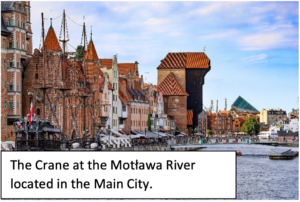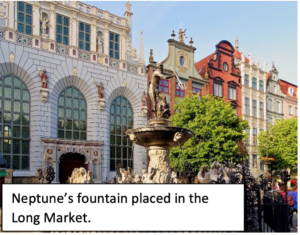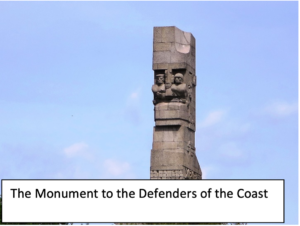
Marvelous Views and Heroic History: Welcome to Gdańsk
By Anna Merchel and Aleksandra Wierzbowska

Welcome to the city of Gdańsk – the fourth largest metropolitan area in Poland with 262 km2 located on the Baltic coast in the northern part of the country. Gdańsk is a city with a history dating back more than a thousand years and breathtaking places worth every minute of your time.
A LITTLE BIT OF HISTORY
Everything began in 997 when Adalbert of Prague baptized many converts and the world first heard about a small stronghold on the Motława River. For centuries, Gdańsk has been developing regardless of its political affiliations. In time, this small port became one of the most important centres of medieval and modern Europe
Despite the many advantages of this position, Gdańsk has also struggled with a history of attacks and oppression which, with the turn of the 20th century, led to crisis. The First World War and the Second World War, which began on 1 September 1939 at Westerplatte, brought about the destruction of the city.
The end of the war began a long and strenuous period of rebuilding. It was a process that continued despite Gdańsk having to fight the communist regime. Citizens of Gdańsk took to the streets to fight for their rights and organized one of the largest strikes in Poland. December of 1970 and August of 1980 were the deciding periods for the fight for democracy throughout the country. Actions of the Independent Self-Governing Trade Union “Solidarity” with Lech Wałęsa as its leader contributed significantly to the fight.
Since that difficult struggle for freedom, Gdańsk has continued to develop under the wing of the democratic Polish state. That’s probably the reason why the Latin slogan “Nec temere, nec timide”, which means “Neither rashly nor timidly”, appears on the city’s large coat of arms.
WHAT’S WORTH VISITING?
To understand the history and evolution of the city, here is a subjective list of the most important places to visit during your stay in Gdańsk:
The most characteristic place worth visiting is the Long Market – a square in the Main City which serves as a market. It dates back to the 13th century when it was a part of the merchant route. It has always been a part of the city inhabited by the wealthiest. Because of the solemn parades conducted on this road in the years 1457-1552, it is also called the Royal Road. In the Long Market there are such places as:
- Main Town Hall – a brick building in the Gothic-mannerist style. Its oldest fragments date back to 1327–1336. It was rebuilt many times and now houses the Gdańsk Museum.
- Neptune’s Fountain – a historic fountain made of bronze in 1612. The design of the figure depicting Neptune was created by the architect and sculptor Abraham van den Blocke.
- The Artus Court – a building constructed between 1476 and 1481, whose name was taken from the medieval legend of King Arthur, a symbol of chivalry and courage. In the past it was a meeting place for merchants and a centre of social life. It later became a stock exchange, and now houses a department of the Gdańsk Museum.
- The Green Gate – was built between 1564 and 1568 by Regier from Amsterdam and Hans Kramer,
a manfrom Dresden. Small bricks, the use of which was unprecedented in Gdansk’s architecture, were employed in the construction of the gate. (The bricks were called Dutch, since they were imported as ballast in a ship from Amsterdam.) Currently, a section of an exhibition of the National Museum in Gdańsk and the Gdańsk Gallery of Photography is located there.
PLACES WORTH VISITING NEAR THE LONG MARKET
- St. Mary’s Church, or in fact the Basilica of the Assumption of the Blessed Virgin Mary – the temple was built in stages over the span of 159 years. In 1502, master Henryk Hetzel laid the last brick on the vault. It is often called the “crown of the city of Gdańsk”.
- The Crane – a historic port crane and one of the water gates of Gdańsk built in 1442-1444. Currently, it is one of the departments of the National Maritime Museum in Gdańsk and the largest and oldest preserved port crane of medieval Europe.
- Museum of the Second World War – a state cultural institution operating since 2017, it presents the history of the civilian population living during the Second World War as well as the uniqueness of the Polish experience.
- Museum of Amber – founded in 2000, houses more than 1000 exhibits, such as blocks with inclusions from 40 million years ago, an amber forest and an amber chamber, and contemporary projects by artists.
- The Gdańsk Shipyard – was established after 1945, in areas where German shipyards previously existed. Over the course of its activity, it has built more than 1000 fully equipped seagoing ships. The Gdańsk Shipyard played a major role in Polish history. A few decisive moments happened there, such as the protests of the workers in 1970, the August agreements of 1980 and the uprising of the Solidarity Trade Union.
- The European Solidarity Centre – an institution whose aim is to promote the heritage of Solidarity and preserve its ideals, namely democracy, an open and solidary society, and the culture of dialogue.
WHERE ELSE TO GO?
- Westerplatte – a peninsula located in the Gulf of Gdańsk, in the harbour channel. A place known from the first battle of World War II which began with the German invasion of Poland.
- The Oliwski Park (dedicated to Adam Mickiewicz) – a historic park in Oliwa, a district of Gdańsk. The park spans 11.3 hectares. It houses the historic Abbots’ Palace built in the Gothic style in the 15th century. Since 1989, the Department of Modern Art of the National Museum in Gdańsk is located there. Another monument in the Oliwski Park is the Oliwska Cathedral, a Roman Catholic archcathedral, which is also a historical monument. It was built in 1224 in a place where the Cistercian order’s wooden church had previously stood. Currently, organ concerts are held there. In the buildings of the former monastery, you can view collections of the Diocesan Museum.
- Pier in Brzeźno – a good place for admiring the beauty of the Baltic Sea. The first pier was founded in 1900 and was 100 meters long. In the interwar period it was extended to 250 meters and 6 meters wide. The first pier was liquidated, and the current pier was built between 1993 and 1996 and is 136 meters long and 7.2 meters wide.

